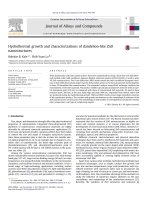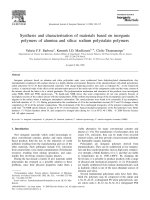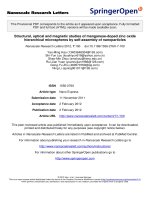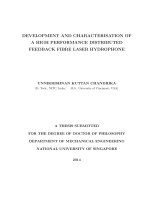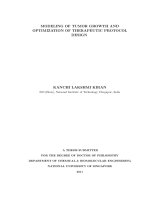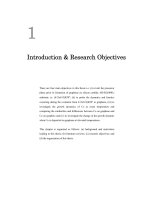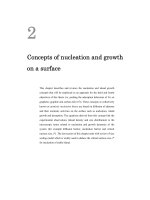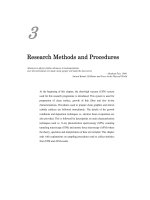Growth and characterisation of cobalt doped zinc oxide 2
Bạn đang xem bản rút gọn của tài liệu. Xem và tải ngay bản đầy đủ của tài liệu tại đây (1.13 MB, 44 trang )
Chapter 2 Cobalt doped zinc oxide
36
CHAPTER
2
COBALT DOPED ZINC OXIDE
2.1 Introduction
Zinc oxide (ZnO) is a wide direct bandgap (3.2eV) semiconductor with a large
exciton binding energy (60meV), which has potential applications in UV light emitters
and detectors.
In recent years, there is also an increasing interest in making ZnO a
dilute magnetic semiconductor. As the valence of Zn in ZnO is +2, it can be readily
replaced by transition metal (TM) ions, enabling interesting magnetic, optical and
electrical properties. In contrast to the low solubility of TM in III-V semiconductors,
ZnO acting as a host material can accommodate more transition metal dopants, making
it a potential candidate for room temperature DMS. Theoretical models
1,2
predicted a T
c
above room temperature for TM-doped ZnO films, which has stimulated numerous
experimental works in obtaining ZnO-based DMSs using various approaches. Although
most of the experimental work has reported some sort of magnetic properties in TM-
doped ZnO (mostly Co and Mn), its origin still remains debatable. In fact, the magnetic
properties reported so far for TM-doped ZnO range from intrinsic ferromagnetism with
various T
c
,
3-10
extrinsic ferromagnetism,
11-13
paramagnetism or superparamagnetism
14-16
to anti-ferromagnetism.
17-19
In the rest of this chapter, I will give an overview of both
the theoretical and experimental work reported so far on TM-doped ZnO. A very brief
introduction to Mn-doped ZnO and Co-doped TiO
2
will also be presented.
Chapter 2 Cobalt doped zinc oxide
37
2.2 Theoretical predictions on TM-doped ZnO
The research on ZnO-based DMS was mainly stimulated by the theoretical
predictions of above room temperature ferromagnetism in 5% Mn-doped p-ZnO with an
acceptor concentration of 3.5 × 10
20
cm
−3
by Dietl et al.
1
These theoretical predictions
were based on the Zener mean-field model, which assumes hole-mediated exchange
interactions between the Mn local moments in which the Mn dopants provide both the
local moments and holes. T
c
is obtained through minimizing the Ginzburg-Landau free-
energy functional, F, with respect to magnetization, M, at given temperature, T, and
hole concentration, p. The free-energy functional, F, consists of two parts: F
c
[M] and
F
S
[M]. The former is due to carrier contribution which is computed based on a six-band
Luttinger–Kohn Hamiltonian together with the p-d exchange contribution. The latter is
parameterized by an exchange energy, N
0
β, the so-called p–d exchange term. The free
energy functional due to the magnetic spins, F
S
[M], is given by
0 0
0
( )
M
dM H M
−
, where
H(M
o
) is the inverse function of the experimental dependence of the magnetization on
the magnetic field, H, in the absence
of the carriers, which is parameterized by the
Brillouin function. T
c
determined is thus given by,
[ ]
( )
(
)
( )
xTT
N
GaAsN
eVN
x
ATTxT
AF
nor
F
o
o
o
eff
FAFFc
−
=−=
2
05.0
)(
β
(2.1)
where A
F
is the Fermi-liquid parameter, x
eff
is the effective spin concentration, β is the
p-d exchange integral, N
o
is the concentration of cation sites, T
F
nor
is the normalized
hole-induced ferromagnetic temperature and T
AF
is the anti-ferromagnetic temperature.
The above results suggest that, in general, higher concentrations of holes and magnetic
ions would lead to DMSs with higher T
c
.
Chapter 2 Cobalt doped zinc oxide
38
A more general model to describe the carrier-spin interactions is the RKKY
model which takes into account both the itinerant nature of carriers and Friedel
oscillations of the electron spin polarization around the localized spins. Although the
oscillation usually averages out, due to small Fermi wavevectors in DMSs, the RKKY is
useful tool to model the random distributions of magnetic spins. Jalbout
et. al. have
carried out Monte Carlo simulations on ZnO:Co based on a three-dimensional RKKY
model.
20
The dependence of RKKY exchange coupling on the density of both localized
spins and itinerant electrons is accounted for by
=
R
F
ex
eff
RGRkFCH )()2( , (2.2)
where C is a positive constant independent of R, F(2k
F
R) is the oscillating function, k
F
is the wave vector at the Fermi surface, and G(R) is a distribution function of the
average number of Co
2+
ions that can be found in a three-dimensional material with the
relative distance R from the central Co
2+
ion. Ferromagnetism is favoured when the
above function is negative; otherwise the system will be non-ferromagnetic. This
requires that 2k
F
R
nearest
< 4.5, where R
nearest
is the average distance of nearest-
neighbouring magnetic atoms. The simulation results showed that ferromagnetism is
favoured in Zn
0.85
Co
0.15
O and Zn
0.75
Co
0.25
O, with carrier concentration of 2.9×10
20
cm
-3
and 1.2×10
18
cm
-3
, respectively.
In addition to the Zener and RKKY models, there were also significant amount
of work devoted to first principles calculations of the T
c
of TM-doped ZnO. A recently
proposed density-functional theory (DFT) calculation for (Co, Al)-co-doped ZnO
suggests that the RKKY interaction is dominant when the distance between Co and Al
is large and double exchange interaction is dominant when this distance decreases.
21
This calculation was performed for a supercell consisting of 32 atoms, with two Co
atoms and one Al atom. The results showed that Co-doped ZnO favours a spin-glass
Chapter 2 Cobalt doped zinc oxide
39
state with anti-ferromagnetic ordering, which is 70 meV per Co ion more stable than the
ferromagnetic state. However, with the addition of Al, which acts as an electron dopant,
the stability of ferromagnetic states is enhanced. It is argued that when the Al-3p orbital
is hybridized with Co-3d orbitals, the doped electrons can go into the Co 3d state and
stabilize the ferromagnetic state, through double-exchange interactions. In this state, the
doped electrons become localized in the Co 3d orbital and cannot be described by the
RKKY model. However, when the Al dopant ion is far from Co, no hybridization can
occur and the dopant electron goes to the host conduction band instead of the Co 3d
orbital. This doped electron thus stabilizes the ferromagnetic state through the RKKY
interactions. Therefore, there is a critical distance between Co and Al atoms which acts
as a boundary between RKKY and double exchange induced ferromagnetism.
Using Korringa-Kohn-Rostoker (KKR) Green function calculations based on
local density approximation, Sato and Katayama-Yoshida predicted that V, Cr, Fe, Co
and Ni doped ZnO are ferromagnetic, Mn doped ZnO is antiferromagnetic, whereas Ti
and Cu doped ZnO remains paramagnetic.
2
The total energy per unit supercell is
calculated by considering a cell with four primitive unit wurzite structure cells, with two
of eight Zn atoms being substituted by two transition metal atoms. The holes are from N
dopants substituting O atoms, whereas the electrons are from Ga dopants replacing Zn
atoms. Fig. 2-1 shows the energy difference between the anti-ferromagnetic state and
ferromagnetic state with no additional carrier dopant. Considering Mn-doped ZnO with
d
5
configuration, there is no additional carrier, and thus resulting in the anti-
ferromagnetic configuration being more stable than the ferromagnetic state. As the
electronic configuration differs from Mn, ferromagnetic becomes favourable again.
From these observations, it is predicted that the resulting mobile carriers stabilizes the
ferromagnetic state through the double exchange mechanism, which prompts the study
Chapter 2 Cobalt doped zinc oxide
40
of dependence of carrier concentration on the stability of ferromagnetic states.
Figure 2-1 Chemical trend of the magnetic states for 3d transition metal atom doped ZnO. Total magnetic
moments per one transition metal atom are also shown. [After K. Sato, 2001, Ref. 2]
Further studies showed that hole-doping stabilizes the ferromagnetic ordering of
Mn, whereas electron-doping stabilizes the ferromagnetic ordering of Fe, Co, or Ni
doped ZnO (see Fig. 2-2).
22
This is of great importance because for practical
applications, n-type ZnO is easier to be produced compared to p-type ZnO. The stability
between spin glass state and ferromagnetic state is compared in ZnO-based DMS as a
function of magnetic ions and carrier dopants. The origin of stabilization of
ferromagnetic state by electron doping comes from electrons participating in a double
exchange mechanism, lowering the energy of the ferromagnetic state. In these doped
materials, the 3d up or down spin states are not fully occupied. Thus, a 3d transition
metal electron in a partially occupied 3d orbital can hop onto the 3d orbital of a
Chapter 2 Cobalt doped zinc oxide
41
neighbouring transition metal, lowering the energy of the system, favouring the
ferromagnetic state.
Figure 2-2 Stability of ferromagnetic state in (a) Mn-, (b) Fe-, (c) Co- and (d) Ni-doped ZnO based DMS
as a function of carrier concentration. A positive energy indicates ferromagnetic state is more stable than
the spin glass state. [After K. Sato, 2001, Ref. 22]
In another study of the effect of electron-doping, the first-principles spin-density
functional calculations by Lee and Chang predicted that heavy electron doping and high
Co concentration are required for obtaining ferromagnetism in ZnO:Co.
23
Without
electron doping, anti-ferromagnetic coupling is favoured over ferromagnetic coupling,
resulting in a spin-glass state. The double exchange interaction, similar to that suggested
above by Sato, is said to stabilize the ferromagnetic state. Ferromagnetic ordering in the
system has a short range of about 3 Å and ferromagnetic interaction does not depend on
the direction of Co ion alignment and Co-Co distances. Calculations suggest that
samples should be prepared with very high electron carrier density of about 10
20
cm
-3
.
Chapter 2 Cobalt doped zinc oxide
42
This is because the ferromagnetic state is favoured when Co-doped ZnO is electron-
doped with above 0.5 electron per Co atom. A large amount of Co doping should also
be used in order to reduce the Co-Co distance and to promote short-range ferromagnetic
ordering. When the Co-Co distance is too large, electron-doping might not be able to
affect the magnetic coupling, thus leading to a less favourable ferromagnetic state.
On the other hand, Spaldin argues theoretically that only hole-doping promotes
ferromagnetism in both ZnO:Co and ZnO:Mn.
24
The calculations were carried out on a
32 atom wurtzite supercell with a single Co atom and a single Zn vacancy, using DFT.
In an undoped ZnO:Co system, the energies of ferromagnetic and anti-ferromagnetic
configurations are similar. However with p-type doping, the ferromagnetic state is
strongly stabilized and is 60 meV lower in energy than the anti-ferromagnetic state.
Interaction with holes causes strong ligand field effects that overcome crystal field
splitting. It is also observed that when two Co ions are in a unit cell, there is an increase
in hybridization of majority electrons with the oxygen p states, compared to an undoped
system.
In contrast to the above findings, Sluiter et al. predicted that both the hole- and
electron-doping are required to promote ferromagnetic ordering in ZnO:Co and
ZnO:Mn.
25
The DFT calculation was carried out on a supercell with 40 formula units of
ZnO, with two Zn atoms being replaced with transition metals, as shown in Fig. 2-3.
From the figure, Ni-, Cr- and Ti- doped ZnO looks like suitable candidates for
ferromagnetism at low concentrations. This is not true in reality, suggesting the need to
modify Mn-, Fe- or Co-doped systems. Li is introduced as a co-dopant in ZnO:Co
system, as it does not contain d electrons to interfere with magnetic calculations and
also has a suitable ionic radius for the system. Li co-doping is found to enhance the
ferromagnetic state as it amplifies the Co pair coupling. Through the use of electron
Chapter 2 Cobalt doped zinc oxide
43
doping with Zn interstitials and hole doping with Zn vacancies or Li, strong
ferromagnetic properties has been predicted and confirmed through experimental
studies, up to room temperature.
Figure 2-3 Magnetic coupling J between substitutional TM atom pairs formed by site 0 and site N,
labelled on the x axis and in the wurzite ZnO supercell (right) where large blue (small red) spheres are
designated Zn (O) atoms. In the supercell, the directions through atoms 1 and 3, 1 and 5, and 0 and 4
correspond to <100>, <010>, and <001>, respectively. Positive J favors FM alignment. [After M. H. F.
Sluiter, 2005, Ref. 25]
Hydrogen-mediated spin-spin interaction was also predicted to be able to induce
high temperature ferromagnetism in ZnO:Co.
26
Through first-principle pseudopotential
total-energy calculations within the local spin density appproximation, interstitial H was
found to help mediate a short-range ferromagnetic spin-spin interaction which affects
the magnetic properties of ZnO:Co in two ways: structurally by forming highly stable
Co dimmers on nearest neighbouring Zn sites and electronically by opening a channel
for strong ferromagnetic spin-spin interaction between the Co dimmers, as shown in Fig.
2-4 below. The highly stable Co dimmer forms a Co-H-Co complex when it reacts with
an ionized H atom. This induces strong ferromagnetic spin-spin interaction between Co
atoms, resulting in room temperature ferromagnetism. The parallel spin pairing state of
(TM-H-TM) is 0.21 eV and 0.26 eV more stable than the anti-parallel state for Co and
Chapter 2 Cobalt doped zinc oxide
44
Mn respectively. Also, the low carrier concentration of a ZnO:Co system is due to a
formation of a deep level by the H in a Co-H-Co complex, resulting in no contribution
to carrier transport.
Figure 2-4
(a) Atomic geometry of a Co-O bond-centered H [H
Bond-Center
-Co]; (b) the most stable geometry of H
bound to a Co dimer (Co-H
Anti-bonding
-Co) complex and (c) The energy diagram for a (Co-H-Co) complex in the
spin-parallel state shows that the hydrogenic level is located deep below the Co-e
g
level.
[After C. H. Park,
2005, Ref. 26]
Coey et al., however, argues that conventional superexchange or double-
exchange interactions cannot produce long-range magnetic order at low concentrations
of magnetic doping. It is proposed that ferromagnetism in DMS is mediated by a donor
impurity band.
27
This spin-split impurity band is formed by oxygen vacancies that form
bound magnetic polarons (BMPs), as shown in Fig. 2-5(a). The T
c
, determined by mean-
field approximation, is dependent on concentration of magnetic cations and donors. The
expression for T
c
is given as
( )
B
o
eff
c
osd
c
k
r
r
fJ
n
xsS
T
3
2
1
2
3
1
+
δ
(2.3)
where S is the spin of 3d cation, s is the donor electron spin, x is the dopant (cation)
concentration, δ is the donor concentration, n is 1(monoxide) or 2 (dioxide), J
sd
is the s-
Chapter 2 Cobalt doped zinc oxide
45
d exchange parameter, f
o
is the oxygen packing fraction, r
c
eff
is the effective cation
radius, r
o
is the oxygen radius and k
B
is the Boltzmann constant.
Figure 2-5 (a) Representation of magnetic polarons. A donor electron in its hydrogenic orbit couples with
its spin antiparallel to impurities with a 3d shell that is half-full or more than half-full. Cation sites are
represented by small circles. Oxygen is not shown; the unnoccupied oxygen sites are represented by
squares; (b) The magnetic phase diagram for dilute ferromagnetic semiconductors. The electrons are
localized in the shaded area. x
p
and
p
are the cation and donor polaron percolation thresholds,
respectively. is the ratio of the radius of the hydrogenic donor orbital to the Bohr radius. [After J. M. D.
Coey, 2005, Ref. 27]
(a)
(b)
Chapter 2 Cobalt doped zinc oxide
46
A high T
c
is only possible when hybridization and charge transfer occurs
between donor-derived impurity band to unoccupied minority-spin or majority 3d states
at Fermi level. Fig. 2.5(b) shows a phase diagram for a DMS system from which
various magnetic phases has been observed, depending on the dopant concentration and
radius of donor orbitals. Polaron percolation threshold, δ
p
, and the cation percolation
threshold, χ
p
, are the critical parameters of the phase diagram. When the concentration
of magnetic cation is sufficiently high, ferromagnetism can occur when δ>δ
p
and χ<χ
p
.
Very recently, it is shown that that spinodal decomposition may occur when the
system is quenched.
28
Spinodal decomposition leads to a complicated random pattern of
high concentration regions connecting to each other. Compared to DMS with
homogeneous impurity distribution, this network could lead to magnetic percolations,
resulting in a high T
c
. Spinodal decomposition is simulated by the Monte Carlo method,
dictating the distance between impurity sites. The T
c
was then calculated using the
random phase approximation for disordered systems.
29
In a uniform DMS system,
magnetic impurities are distributed randomly and the system T
c
is low, due to the lack
of magnetic percolation paths. In a quasi-one-dimensional structure, large clusters with
high anisotropic shape can form, even with low dopant concentrations. Spinodal
decomposition, in a layer by layer growth condition, lead to formation of quasi-one-
dimensional structures in DMS, making delta-doping a favourable technique to obtain
room temperature ferromagnetism. One delta-doped layer, with impurity concentration
of 5 %, can lead to T
c
of 346 K.
Chapter 2 Cobalt doped zinc oxide
47
2.3 Experimental Work on Co doped ZnO
2.3.1 Early observations
Ueda reported transition-metal Co-, Mn-, Cr-, Ni-doped ZnO on sapphire
substrates deposited by the pulsed laser deposition (PLD) technique.
3
This growth
technique was used because it was believed to be able to obtain a higher solubility of
magnetic ions in the ZnO host matrix. The TM-doped ZnO films were deposited at 350
– 600
o
C in 2 – 4 ×10
-5
Torr oxygen environment, on Al
2
O
3
(1120) substrates. Ceramic
targets with 1 wt% of Al were used to produce n-type ZnO. From XRD studies, as
shown in Fig. 2-6 (a), the Co-doped ZnO films prepared were single phase, with a c-
axis preferred orientation. The Co atoms systematically substituted the Zn atoms,
without changing the ZnO wurtzite structure, as seen from the linear increase of d(002)
values with Co concentration illustrated in Fig. 2-6(b). Their results also showed that
the Co-doped films has the highest solubility limit, of <50 %. The substitution of Zn
was confirmed by the d-d transitions of Co ions, from absorptions peaks occurring at
570, 620 and 660 nm, in the optical transmission spectra. Moving on to magnetic
studies, the temperature dependence of magnetism showed that the films have a T
c
around room temperature and a Zn
0.95
Co
0.05
O film has a coercivity of 50 Oe at 6K, as
show in Fig. 2-6(c) and (d) respectively. The presence of weak ferromagnetism from
CoO had been ruled out as an origin of the observed ferromagnetism. They believe that
the ferromagnetic properties of the higher carrier concentration samples are carrier-
mediated, through RKKY or double exchange mechanism. These samples exhibited
ferromagnetic properties with higher T
c
and saturation magnetization, whilst other
samples exhibiting spin glass behaviour. The Cr, Ni and Mn doped films prepared did
not exhibit any ferromagnetic behaviour.
Chapter 2 Cobalt doped zinc oxide
48
(a)
(b)
(c)
(d)
Figure 2-6 (a) 2θ-θ XRD scan of Zn
0.95
Co
0.05
O film; (b) c-axis lattice constant d(002) dependance on Co
concentration; (c) Magnetization vs temperature curves measured in field of 0.1 T for various samples; (d)
hysteresis curves measured at 6 K of Zn
1–x
Co
x
O (x = 0.05 and 0.15) films. [After K. Ueda, 2001, Ref. 3]
After this pioneer work, a lot of work has been done on TM-doped ZnO. In what
follows, an overview of the growth techniques and conditions used in depositing the
films is given. Some typical or interesting results and problems encountered during
characterizations are also discussed.
2.3.2 Growth of Co-doped ZnO
The various common growth techniques that have been used for fabricating Co-
doped ZnO films include PLD, metalorganic chemical vapor deposition (MOCVD),
molecular beam epitaxy (MBE), sputtering and sol-gel methods (see Table 2-1). The
PLD, MOCVD and MBE methods were known to produce undoped ZnO with a better
crystalline quality as compared to the other two techniques; however their advantages
are not reflected in the highly doped DMS samples, specifically in the case of Co-doped
Chapter 2 Cobalt doped zinc oxide
49
ZnO. The ultimate aim of these different growth techniques is to obtain Co-doped ZnO
with a high concentration and uniformly distributed Co, without the formation of any
secondary phases. With the different deposition methods, it is found that the structural
and physical properties of Co-doped ZnO oxides were strongly dependent on the growth
conditions, dopant types, and post-deposition annealing, which will be discussed further
in the next sections. It is important to take note that the thermal solubility limit of Co in
ZnO ranges from 10% to 25%, depending on the growth techniques and conditions used.
Table 2-1 Co doped ZnO systems.
Films Fabrication Technique Magnetic Properties Reference
Zn
1-x
Co
x
O
(0 ≤ x ≤ 0.25)
Sol gel method Intrinsic ferromagnetism 6
Zn
0.9
Co
0.1
O PLD Intrinsic ferromagnetism 8
Zn
1-x
Co
x
O
(0 ≤ x ≤ 0.35)
MOCVD Intrinsic ferromagnetism 9
Zn
0.964
Co
0.036
O Spin coating Intrinsic ferromagnetism 10
Zn
1-x
Co
x
O
(0 ≤ x ≤ 0.20)
Sol gel method,
sputtering
Extrinsic ferromagnetism 11
Zn
0.75
Co
0.25
O PLD Extrinsic ferromagnetism 12
Zn
1-x
Co
x
O
(0 ≤ x ≤ 0.15)
Combustion method Extrinsic ferromagnetism 13
Zn
1-x
Co
x
O
(0 ≤ x ≤ 0.15)
MBE Paramagnetic 14
Zn
0.99
Co
0.01
O
Zn
0.97
Co
0.03
O
Modified melt-growth
method
Paramagnetic 15
Zn
1-x
Co
x
O
(0 ≤ x ≤ 0.15)
Precursor decomposition Anti-ferromagnetic 17
Zn
1-x
Co
x
O
(0 ≤ x ≤ 0.10)
Coprecipitation method Anti-ferromagnetic 18
Chapter 2 Cobalt doped zinc oxide
50
2.3.2.1 Growth conditions
For every growth method, fine-tuning of the growth conditions is crucial to
obtain films with good homogeneity and reproducible properties. Many groups studied
the influence of substrate temperature and oxygen pressure on the magnetic properties
of obtained films. Generally, a lower substrate temperature (600
o
C) and higher oxygen
pressure (> ×10
-5
Torr) are able to produce films with homogeneous Co distribution.
Fig. 2-7 shows how the substrate temperature and atmospheric environment affect the
structural properties of the films prepared by PLD.
12
The homogeneity of the film is
generally improved by lowering the substrate temperature. The oxygen partial pressure
during the growth affects the formation of oxygen vacancies, which in turn may affect
the magnetic properties of the film. In Co-doped ZnO, the experimental results have
shown that the oxygen vacancies can enhance ferromagnetism through the formation of
BMPs.
30
Although a low oxygen pressure improves the ferromagnetic exchange
interactions,
31
it has also been reported that a high oxygen pressure can suppress the
formation of Co clusters.
32
Figure 2-7 Growth phase diagram of Zn
0.75
Co
0.25
O
films in relation to substrate temperature and O
2
pressure. Open circles and crosses denote homogeneous (Zn
0.75
Co
0.25
O) and inhomogeneous
(Zn
0.75
Co
0.25
O + CoO + Co) structures, respectively. [After J. H. Kim, 2002, Ref. 12]
Chapter 2 Cobalt doped zinc oxide
51
2.3.2.2 Choice of dopants
As ZnO can be both p-type and n-type doped, the choice of electrical dopant
would be important especially if ferromagnetism is dependent on donor energy levels.
Kittilstved et. al. demonstrated that the control of electronic structure and polarity is
critical to achieving high T
c
ferromagnetism of transition metal doped ZnO.
33
As shown
in Fig. 2-8, the choice of dopant is important in determining the material properties. P-
type ZnO:Co doped with nitrogen was found to be non-ferromagnetic, whereas non-
nitrogen-doped ZnO:Co (n-type) exhibits ferromagnetic behaviour. The opposite
behaviour was observed in Mn-doped ZnO. Thus, it has been shown that
ferromagnetism in DMSs is very much dependent on dopant-donor/acceptor
hybridization.
Figure 2-8 300 K magnetization data for 0.2% Mn
2+
:ZnO and 3.5% Co
2+
:ZnO films prepared by direct
chemical synthesis with or without addition of nitrogen. (a) 0.2% Mn
2+
: ZnO with added nitrogen, (b)
0.2% Mn
2+
:ZnO without added nitrogen, (c) 3.5% Co
2+
:ZnO with added nitrogen, and (d) 3.5% Co
2+
:ZnO
without added nitrogen. [After K. R. Kittilstved, 2006, Ref. 33]
Chapter 2 Cobalt doped zinc oxide
52
Other than the dopants used above, Cu doping was found to improve
ferromagnetism in Co-doped ZnO system.
34 , 35
The results showed that Cu doping
drastically changes the magnetic properties of the films, as seen in Fig. 2-9. The amount
of Cu doping is about 1-4 at% and in both works, the films are believed to be
homogeneous and free of secondary phases and nanoclusters. The improvement of
ferromagnetic properties from additional Cu-doping is attributed to the enhancement of
carrier concentrations.
Figure 2-9 M-H curves of (a) Zn
0.95
Co
0.05
O and (b)Zn
0.94
Co
0.05
Cu
0.01
O at room temperature (RT) and 78 K.
Inset in (b) shows the M-H curve at RT with its y-axis enlarged. [After O. D. Jayakumar, 2005, Ref. 35]
2.3.2.3 Post-growth annealing
Different post-growth annealing in different atmosphere has also been carried
out by various groups to try to reveal the origin of ferromagnetism in Co-doped ZnO. In
the study by Khare et. al., the presence of Zn interstitial or oxygen vacancies is believed
to introduce free carriers, which promote ferromagnetism.
36
By annealing their sample
in Zn vapour atmosphere, they observed ferromagnetism in their films, although there is
no noticeable change in resistivity (see Fig. 2-10). On the other hand, annealing the
samples in oxygen atmosphere leads to a reduction in M
s
and similar to Zn annealing,
the resistivity of the film remains constant. Their results show that ferromagnetism is
(a)
(b)
Chapter 2 Cobalt doped zinc oxide
53
not linked to conductivity although the annealing atmosphere does show an effect on
ferromagnetism.
Figure 2-10 Room temperature M-H curves for Zn
0.98
Co
0.02
film before and after annealing in Zn vapour
at 410
o
C.
[After N. Khare, 2006, Ref. 36]
In another post-growth annealing study, it was found that the magnetisation
varies with the amount of oxygen vacancies in ZnO, which in turn affects the formation
of BMPs.
30
In this study, the samples were annealed in air, Ar and Ar/H
2
atmospheres,
producing films which have M
s
values of 0.2, 0.9 and 1.5 µ
B
/Co respectively. In
comparison, the as-deposited films have an M
s
of 0.5 µ
B
/Co at room temperature (see
Fig. 2-11). In Ar/H
2
and Ar annealing atmospheres, resistivity decreases due to the
presence of more oxygen vacancies, as determined from x-ray near edge spectroscopy
studies. On other hand, films annealed in air have less oxygen vacancies, making them
highly insulating. With the ferromagnetism varying with oxygen vacancies, the model
of BMPs can be used to describe the origin of ferromagnetism in these Co-doped ZnO
samples.
Chapter 2 Cobalt doped zinc oxide
54
Figure 2-11 M-H curves for as-deposited and annealed Co:ZnO films at room temperature.
[After H. S.
Hsu, 2006, Ref. 30]
2.3.3 Characterization of Co-doped ZnO
The common methods used in the characterization of Co-doped ZnO are listed
in Table 2-2 and those used in this study will be described further in Sections 3.2.
Although these methods have been used in one way or another to characterize Co-doped
ZnO, a systematic method to conclude intrinsic ferromagnetism has yet to be
established. A general approach adopted is to “prove” the absence of clusters/secondary
phases through the use of XRD and TEM, coupled with observation of d-d transitions of
Co
2+
in optical measurements, and subsequently any ferromagnetism observed is
deemed intrinsic. The study of transport properties has often been left out in many
papers, which is important because the correlation between magnetic and transport
properties is critical in determining if they exhibit carrier-mediated ferromagnetism. In
addition, one should also carry out experiments on one set of samples, instead of
samples prepared in different periods with similar chemical compositions, as
reproducibility of samples is very much dependent on the condition of the growth
Chapter 2 Cobalt doped zinc oxide
55
system. In the following sections, the commonly observed characterization results and
also various interesting findings will be explored.
Table 2-2 Properties and their corresponding characterization methods.
Properties Characterization method
Structural
• XRD
• TEM
• X-ray photoelectron spectroscopy (XPS)
• Atomic force microscopy (AFM)
• Auger electron spectroscopy (AES)
• Energy dispersive x-ray analysis (EDX, EDS)
• Rutherford backscattering spectrometry (RBS)
• Secondary ion mass spectrometry (SIMS)
• Electron energy loss spectroscopy (EELS)
Optical
• Optical transmission
• Photoluminescence (PL)
Magnetic
• Superconducting quantum interference device (SQUID)
• Vibrating sample mangetometer (VSM)
• MCD
Transport
• Magnetoresistance (MR)
• Resistivity measurements
• Conductance measurements
• Hall effect
2.3.3.1 Structural and optical studies
As mentioned above from Ueda’s work, XRD is commonly used to show that
Co is able to substitute Zn without changing the ZnO wurtzite structure. Table 2-3
summarized the peak position of ZnO (002) for various Co-doped ZnO films on Al
2
O
3
(0001) substrates. The peak position of pure ZnO (002) is 34.422
o
, however, with the
Chapter 2 Cobalt doped zinc oxide
56
substitution of Zn with Co, strain is introduced into the lattice, leading to a shift of the
peak position. From the plot of d(002) versus Co concentration, one can roughly
estimate the solubility limit of Co in ZnO, i.e., the composition at which the breakdown
of Vegard’s law occurs. The absence of any additional peaks in a XRD scan is also
often used to eliminate the presence of Co cluster and secondary phases, which are
further confirmed through high-resolution TEM observations. Although XRD and TEM
are able to probe the crystalline structure of the films grown, it is sceptical that they can
“confirm” the absence of clusters of very small size, which has often been used as a
support of intrinsic ferromagnetism in Co-doped ZnO films. It should thus be noted that
not all particles that contribute to ferromagnetism are detectable by XRD or TEM
techniques, especially when the particles are very small or have a lattice structure which
is almost identical to that of the host material.
Table 2-3 XRD results from various groups.
Sample Growth Method
2θ peak position (
o
)
Reference
Zn
0.98
Co
0.02
O CVD 34.521 36
Zn
0.96
Co
0.04
O PLD 34.195 37
Zn
0.95
Co
0.05
O Co-precipitation 34.549 35
Zn
0.90
Co
0.10
O PLD 34.398 38
Zn
0.85
Co
0.15
O PLD 34.521 39
Zn
0.80
Co
0.20
O Sol-gel 34.371 6
Zn
0.75
Co
0.25
O PLD 34.412 12
The uniformity of Co distribution throughout the film is of equal importance as
the structural properties determined via XRD and TEM. The homogeneity of the film
can be checked by AES, EDX, EELS, RBS and SIMS. Inhomogeneous samples will
give incorrect interpretations of measurement results especially when both local and
Chapter 2 Cobalt doped zinc oxide
57
global characterization techniques are used. A film characterized via TEM might be
homogeneous due to the small area studied, however for XRD characterization, it is
likely to be considered inhomogeneous as the area studied is large. Also, given the
amount of Co doped into ZnO is of small quantity, compositions of films determined
must have significant amount of accuracy.
In determining the composition of the film, XPS, RBS and EDX are commonly
used, although these techniques have limited accuracy. After obtaining films with good
structural quality and homogeneity, it is important to confirm Co substitution into the
ZnO host matrix
One method to “confirm” if Co has replaced Zn is to check the valence state of
Co which is normally determined by XPS, AES and EELS. Although the valence state
of Co in the films can be determined from XPS, AES and EELS, it should be noted that
secondary phases might be responsible for the valence state.
Optical transmission can also be used to show Co substitution of Zn in the host
lattice, through the observation of characteristic peaks (see Fig. 2-12). Absorption bands
observed at 571, 618 and 665 nm are characteristic of d-d transition of tetrahedrally
coordinated Co
2+
of
4
A
2
(F) →
2
A
1
(G),
4
A
2
(F) →
4
T
1
(P), and
4
A
2
(F) →
2
E(G) transitions
respectively.
40
These peaks observed from optical transmission spectrum can be used
together with results from EELS and XPS to confirm Co
substitution of Zn, but they
should not be used to confirm Co
2+
is the origin of ferromagnetism. The observation of
these peaks can only confirm the presence of tetrahedrally coordinated Co
2+
ions in the
ZnO host matrix. The correlation of the above structural results with those obtained
from magnetic and transport techniques are necessary before confirming the origin of
ferromagnetism.
Chapter 2 Cobalt doped zinc oxide
58
Figure 2-12 Optical transmission of d-d transitions in Ni, Fe, Mn and Co-doped ZnO films. [After Z. W.
Jin, 2000, Ref. 41]
2.3.3.2 Magnetic studies
The magnetic properties are generally characterized by SQUID and VSM
through the measurement of M-H loops, field cooled (FC) and zero field cooled (ZFC)
curves. Magnetic properties of Co-doped ZnO can be in the form of paramagnetic,
ferromagnetic, antiferromagnetic and spin-glass behaviour. Typical magnetic data of
ferromagnetic samples are similar to those in figures 2-6 (c) and (d). Similar to the
many different magnetic properties, T
c
reported also spans a wide range from 5 K to
above 300 K. Interpretation of magnetic data would be further complicated if the films
is non-homogeneous or contain secondary phases. Before interpretation, high-field
diamagnetic response of substrate should be subtracted from the results obtained.
However, when this is done, some important information, in particular paramagnetic
moment of ZnO:Co, would be lost.
An interesting study by Dinia reported that Zn
0
.
75
Co
0.25
O films, deposited at 600
o
C by reactive magnetron co-sputtering, exhibit clear perpendicular anisotropy, as
shown in Fig. 2-13.
42
Compared to another sample deposited at 400
o
C, which exhibited
Chapter 2 Cobalt doped zinc oxide
59
no perpendicular anisotropy, there is however no direct correlation between structural
quality and magnetic properties. XRD studies show the film has a full-width-half-
maximum (FWHM) of 0.8
o
, which indicates good structural quality, and is also free
from Co metallic clusters. ZFC and FC curves are superimposed on each other,
eliminating the presence of metallic clusters, which could lead to superparamagnetism.
Figure 2-13 M-H curves of samples deposited at (a) 400
o
C and (b) 600
o
C, with magnetic field applied
along (open circle) and perpendicular (solid circle) to the film plane, at 10 K. Insets show the M-H curves
for magnetic fields -1000 to 1000 Oe, with magnetic field perpendicular to film plane. [After A. Dinia,
2005, Ref. 42]
It is also important to take note that the magnetic properties as determined might
not just be from Co-doped ZnO, but also from ferromagnetic impurity phases. In highly
concentrated magnetic semiconductors, Sato et al. showed that spinodal decomposition
(a)
(b)
Chapter 2 Cobalt doped zinc oxide
60
inherently occurs due to strong attractive interactions between impurities, leading to
high T
c
ferromagnetism with the formation of magnetic networks.
28
Extrinsic
ferromagnetism can also be in the form of secondary phases, like ferromagnetic Co,
CoZn and ZnCo
2
O
4
, with T
c
of 1373 K,
43
468 K
44
and 45 K
45
respectively, and also
antiferromangetic CoO and Co
3
O
4
with Neel temerature 291 K
46
and 40K
47
respectively.
The critical diameter for superparamagnetism in hexagonal Co spheres at room
temperature is ~2-5 nm, which should be observable in TEM images.
48
Cubic spinel p-
type ZnCo
2
O
4
, prepared by reactive magnetron sputtering, is a hole-mediated DMS,
with the concentration type and carrier concentration dependent on oxygen partial
pressure.
45
Bulk CoO in rock-salt structure is known to be an antiferromagnet, however,
small CoO nanoparticles can be ferromagnetic due to frustrated surface spins.
49
In such
cases when films are inhomogeneous, interpretation of magnetic data is very
complicated.
In cases of inhomogeneous ferromagnetic samples, MCD is a useful technique
to characterise their magnetic properties. Magnetic properties characterized by MCD are
carried out using either light or x-ray. The advantage of optical MCD is that it is
wavelength selective and thus is able to probe sp-d interaction in both the host matrix
and secondary phases. Ando et. al. observed that Sc, Ti, V and Cr doped ZnO did not
show observable magneto-optical effects, whereas Mn, Co, Ni and Cu doped ZnO show
pronounced negative MCD peaks at 3.4 eV, corresponding to the bandgap of ZnO (see
Fig. 2-14).
50
Comparing the samples studied, MCD shows the largest effect for Co-
doped ZnO. Co-doped ZnO also show MCD structures near 2 eV, due to d-d transitions
of Co
2+
ions. The MCD spectrum shape can also change with temperature, providing
more information of the magnetic properties of the samples.
